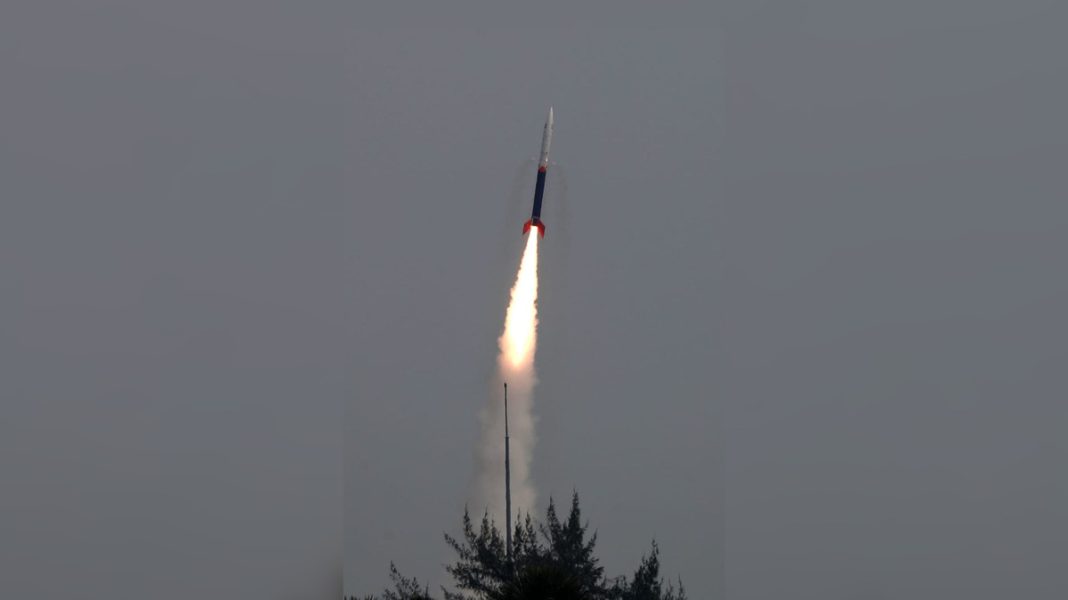India witnessed a historic moment on November 18, 2022, at precisely 11:30 a.m. with the successful launch of Vikram S. It became the first privately developed rocket in India’s trajectory when it lifted off from ISRO’s launch pad at Sriharikota. The name Vikram S has been inspired by and is a tribute to the father of the Indian space program, Vikram Ambalal Sarabhai, and the mission was named “Parambh,” which in Hindi means “beginning.” Read the blog further to get an idea about Vikram S. and what this new beginning promises.
Vikram S: An Overview
Vikram S is a suborbital, single-stage rocket developed by Skyroot Aerospace Private Limited. It was built within a whopping time frame of only two years following the Indian government’s announcement to open up space projects to private companies in 2020. The mass of Vikram S is 545 kg (1201.52 lb), and it stands tall at a length of 6 m (19.6 ft). With a diameter of 0.375 m (1.23 ft), the rocket has a payload capacity of 83 kg (182.98 lb) at 100 km (62.13 m) altitude. With a capability to reach more than Mach 5 (6174 km/h), the rocket has a peak vacuum thrust of 7 tonnes (7.71 US tons) and a peak combustion pressure of 80 bar. Vikram S carried three customer payloads, which included Bazoomq (Armenia), N Space Tech (India), and Space Kidz India.
Within 5 minutes of the launch, Vikram S splashed into the Bay of Bengal, hitting an altitude of 89.5 km (55.61 m). By ticking all the boxes of flight parameters, the rocket has validated almost 80% of the technologies that will be further used for the Vikram series as planned by the company. The launch vehicle used the Kalam-80 engine, and for spin stability, it had 3D-printed solid thrusters. The Vikram S has a core structure made of carbon fiber and has an updated avionics system that includes an onboard camera, tracking device, a data acquisition tool, telemetry, GPS, power systems, and an inertial measurement device.
Skyroot: Developers of Vikram S
Established in July 2018 by former ISRO scientists Pawan Kumar Chandana and Naga Bharath Daka with the help of Vasudevan Gnanagandhi, Skyroot Aerospace became the first private entity to sign an agreement with the Department of Space to access ISRO’s expertise and facilities.
Skyroot was established with the mission to make the boundaries of “space” available to the masses with its cutting-edge technology, where the concept of space amalgamates seamlessly with everyday life. The venture was already successfully building rocket components for clients before the Vikram S launch and rightfully won the National Startup Award in 2020 and the Aegis Graham Bell Award in the innovation category. It has raised Rs. 5.26 billion ($64.42 million) and has 200 employees, of whom 100 were meticulously involved in the Vikram S launch. The company is developing three Vikram series rockets, with the Vikram I set to launch in the third quarter of 2023. The rockets of the Vikram series will depend on various solid and cryogenic fuels, and Skyroot is building them to launch small satellites. With the ability to tackle interplanetary missions and multi-orbit insertion, the rockets can be assembled and launched within 24 hours from any launch site.
Other private entities in India
Following the Indian government’s policy to enhance public-private partnerships in space exploration and research, many other private entities like Skyroot have come up. Some popular ones among them are:
Agnikul Cosmos: The startup is building 3D-printed rocket engines and has successfully tested them. These engines are going to replace the assembly models.
Bellatrix Aerospace: A small satellite company and a private aerospace manufacturer established in 2015, Bellatrix Aerospace has plans to launch its own rocket in 2023, named Chetak.
Digantara: With so many aerospace companies pursuing space exploration, tracking and monitoring debris is a critical component of any project. Digantara is the first Indian company that is exactly doing so by helping in the tracking and monitoring of space junk with the development of an in-orbit device.
Promises for the future
With the joint effort of ISRO and Skyroot, the launch of the Vikram S promises a bright future. Some key points that one can take from this launch are:
- With the involvement of the private sector, ISRO can not only get a new pool of resources and talent but also venture into human space flight ventures, exploit new technologies, and have more exploration missions.
- The expected growth rate of the space economy globally is 6.84% by 2026. With the inclusion of private industries, India can also become a powerhouse in space technology and ride this growth.
- With the easy access of space assets to industries and other parties like academic bodies, researchers, or students, the efficient utilization of resources will occur.
- Private industries can play a great role in bringing in foreign investments and cooperative opportunities, which can also help create jobs.
Conclusion
Though many challenges lie ahead, the acceptance of private industries in the Indian space sector is no doubt a milestone. With the launch of the Vikram S, India marks a new dawn that will eventually transform the lives of millions.
See more: Jio Cinema Meltdown In The Opening FIFA World Cup 2022 Match: Explained


